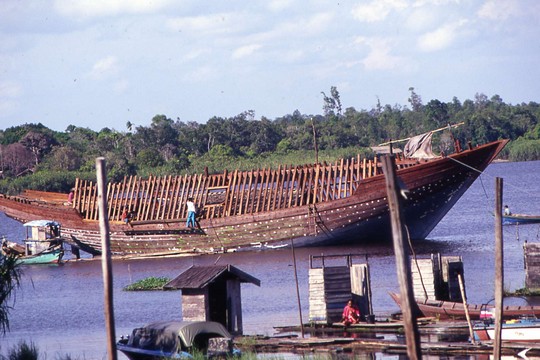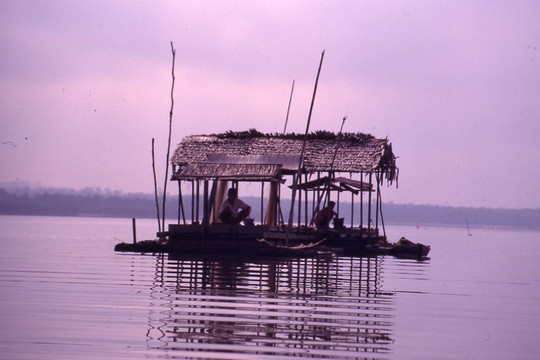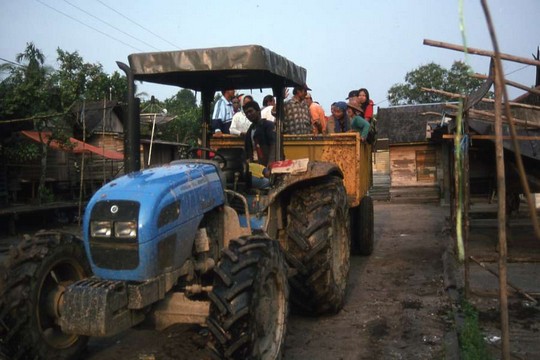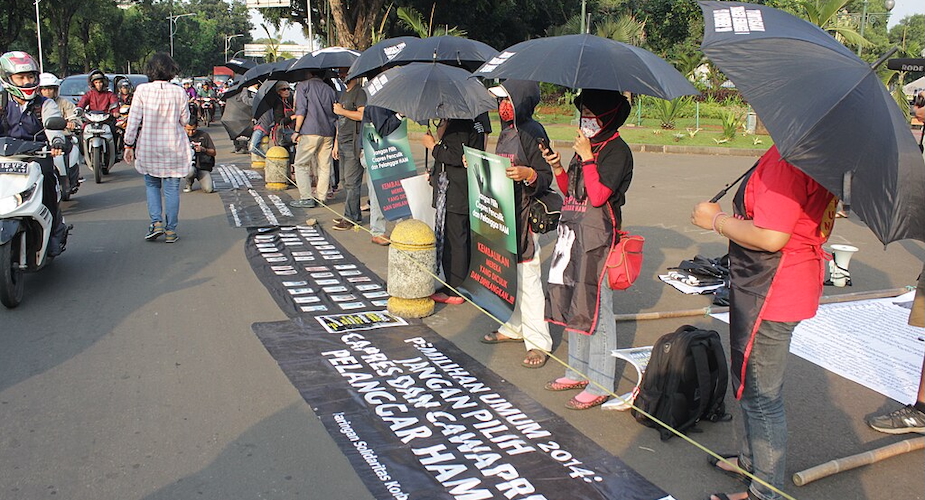A community in Central Kalimantan, unable to claim indigenous status, finds it difficult to defend its resources against global capital
Greg Acciaioli
The landscape of Borneo – offshore oil-rich Brunei excepted – is becoming increasingly a patchwork of plantations, as stretches of felled rainforest are replaced by regimented rows of oil palms. As the world’s most productive oil crop, producing up to ten times more oil per unit area than any other, oil palm (kelapa sawit in Malay and Indonesian) has sparked a boom in the Malaysian and Indonesian economies, as world demand for crude palm oil has rocketed.
There has long been demand due to the use of palm oil in food products, such as cooking oil, shortening, margarine, and cocoa butter, and of palm kernel oil in the oleo chemical industry – soap, detergent, cosmetics and other toiletries. This demand has now been heightened due to palm oil’s use as a feedstock for biodiesel. Indonesia achieved its goal of surpassing Malaysia as the world’s top palm oil producer in 2006, when over 6 million hectares had been planted in oil palms, mainly in Sumatra and Kalimantan.
Oil palm plantations introduced earlier in Sumatra and West Kalimantan took the form of government enterprises using the ‘nucleus-plasma’ model. A large plantation, usually with facilities to produce crude palm oil, formed the ‘nucleus’, while smallholdings, usually of two hectares, constituted the surrounding ‘plasma’. In Central Kalimantan, however, oil palm only began entering in a big way after the International Monetary Fund introduced structural adjustment in the 1990s.
Structural adjustment was to be achieved through private investment, and large corporations were not interested in promoting smallholdings. So, despite national legislation making smallholder plots mandatory, throughout Central Kalimantan oil palm investment has taken the form almost exclusively of large plantations owned by conglomerates or business groups, often run as joint ventures with foreign investors. Privatisation of the sector has prevailed.
In recent years, estate companies have been pressured to provide more just compensation to local peoples whose customary land they have appropriated to establish plantations. The demand for such compensation has been catalysed by the campaigns of NGOs linked to the international Indigenous Peoples movement. In the Indonesian context this has included such organisations as WALHI (Indonesian Forum for the Environment) and AMAN (The Alliance of Archipelagic Indigenous Peoples). However, the people forgotten in such campaigns are the non-indigenous settlers whose lands have also been taken. Such peoples include many ‘coastal Malay’ migrants living in the forests of Borneo. One group is the Islamic Banjarese of Central Kalimantan.
The Banjarese of Central Kalimantan
When the Norwegian explorer Carl Lumholtz wanted to hire porters to travel from Lake Sembuluh to Sampit in Central Borneo during World War I, the local Sembuluh villagers refused. They claimed they could earn much more cultivating their smallholder rubber. The refusal of these Banjarese migrants – Lumholtz labelled them ‘Malay intruders’ – indicates their early engagement with a global capitalist market.
Central Kalimantan was established as a separate province in 1957 to serve as a ‘Dayak homeland’ freed from the dominance of the Banjarese, the largest ethnic group of South Kalimantan. However, Banjarese still inhabit the towns and the villages scattered along the rivers running from north to south throughout Central Kalimantan. In some areas they remain the dominant group, including in the main villages along the southern and eastern stretches of Lake Sembuluh. This lake empties into the Seruyan River about four hours upstream from Kuala Pembuang, the capital of the recently formed district of Seruyan.
 |
|
One of the last ships for carrying timber from Kalimantan to Java still under construction on Lake Sembuluh in 2004. / Greg Acciaioli |
The Sembuluh Banjarese participated in the timber boom that led to Central Kalimantan having one of the wealthiest and fastest-growing economies in Indonesia in the 1970s and 1980s. They used local ironwood to build uniquely designed ships which were used to transport timber from Central Kalimantan to Semarang and other ports of Java. This industry attracted both Madurese and Bugis craftspeople from other parts of Indonesia, but the leaders of these ship-building enterprises were Sembuluh Banjarese.
Today this industry has disappeared. As one Sembuluh villager explained in 2004, ‘In the past among the members of our society, what they worked at was building ships of ironwood, but now that the large oil palm plantations have come in, that culture has been lost. Why has that happened? The basic materials that we needed from our own forest are now extinguished, hauled away by the large plantations.’
Plantation proliferation and livelihood loss
Given the poor quality of its soils, estate crops have long dominated agricultural production in Central Kalimantan. Local smallholders have long tapped latex, for processing into natural rubber, and sap from the jelutung tree, which can be processed into a material much like rubber. More recently, oil palm has become the crop of choice. Since the 1990s, large-scale oil palm plantations have been established throughout the province. Both rubber and jelutung can be integrated into forests, but oil palm plantations require clearing the forest entirely in order to introduce a monoculture.
The proliferation of new districts as a result of regional autonomy legislation passed in 1999 has accelerated deforestation and the spread of plantations. District heads (bupati) have mounted aggressive fund-raising schemes to raise the local revenue needed to fund district salaries, government office construction, and other infrastructure. Seruyan, established as a new district in 2002, is typical. Its first head, a Banjarese contractor from Sembuluh, prolifically distributed plantation concessions in order to raise government revenues.
By the mid-2000s, Lake Sembuluh was almost entirely ringed by oil palm plantations. Although the district head hailed this as a strategy aimed at increasing people’s prosperity, many of the Sembuluh Banjarese view this as what one person described to me as a ‘foolhardy policy’. What they experience is the destruction of local livelihoods. Fishers who could earn up to Rp.300,000 for a day’s catch in the rainy season, now can hardly get any income. The run-off from pesticides, fertilizers and other inputs used to promote oil palm productivity has killed most of the fish in the lake.
Fishers do not see the option of serving as labourers in the plantations as increasing their prosperity. There, they will earn less than Rp.20,000 (about US$2) per day. The plantations also affect local farming options. Nobody can plant dry rice safely in their vicinity. The plantation monoculture environment has accelerated the breeding of locusts, which periodically swarm, destroying any rice fields in their paths. Although the companies claim only to be converting scrub land and land overgrown with elephant grass, participatory community mapping has revealed that many gardens have been included in their clearing efforts, not to mention large stands of secondary forest.
Land problems in the absence of adat
Land compensation has been another big problem. The Banjarese of Sembuluh do not subscribe to local Dayak custom (adat) relating to land tenure. Local Dayak land tenure is based on the right of first clearance: whoever first clears a garden or field has continuing rights to use of that land. Proclaiming themselves Muslims oriented to modern institutions and practices, the Sembuluh Banjarese do not adhere to any such principles; they admit that they have traditions and usages, but not adat. They do not acknowledge the authority of the local Dayak adat official who assists the subdistrict officer in settling customary claims.
As a result, the Sembuluh Banjarese do not have clear principles and procedures to determine conflicts over land tenure. If a person does not use land continuously, such as by planting fruit trees on it, then after some years of non-use others can cultivate that land without gaining permission or even consulting the plot’s previous cultivator. When plantation companies seek to compensate local people for their land, competing claims arise regarding who has ownership rights over the land in question. Not surprisingly, as plantations have expanded the Sembuluh villages have become rife with social conflict.
Resistance against the oil palm plantations
Sembuluh villagers have not simply acquiesced in this situation. When PT Agro Indomas built a 40-metre long bridge connecting two sections of plantation fields as part of site preparation in 1995, several villagers soon severed it. They also seized company equipment, including tractors and a backhoe. However, such local resistance has been of little use in halting estate expansion.
Nongovernmental organisations (NGOs) located in the provincial capital, Palangkaraya, have facilitated various campaigns against the industry. The Central Kalimantan branch of WALHI has been working together with the Bogor-based Sawit Watch. Besides the community mapping already mentioned, NGOs have also organised demonstrations in Sampit, Central Kalimantan’s main economic centre, and run publicity campaigns about the Sembuluh situation. They have also helped form several people’s organisations, of which KOMPAK Sembuluh (Community of the Local Society of Environmental Managers of the Sembuluh Region) has been the most active.
 |
|
Sunset over Lake Sembuluh / Greg Acciaioli |
KOMPAK Sembulu’s staff have mounted letter-writing campaigns, for example demanding that one plantation company (PT Kerry Sawit Indonesia) employ local people as managers as well as labourers, provide wages meeting the daily needs of local people, contribute to village development and provide concrete evidence that its activities do not harm the environment. The SPPD (Union of Youths Concerned for their Region), a complementary youth organisation in Sembuluh, has been more confrontational, for example, assembling demonstrations at the entrances to company plantations. It has also worked to educate the local populace about their rights and entitlements to land and other natural resources. It educates people about the need to protect their intellectual property rights in regard to the medicinal uses of local plants that might be sought by pharmaceutical companies.
However, these efforts have so far yielded little. Part of the problem is that even in phrasing their demands the Sembuluh Banjarese are caught in a contradiction. On the one hand, they wish to use modern organisations and tactics to press their claims as an increasingly impoverished rural class. On the other, they recognise that their claims will only be heeded by the companies and gain international recognition if they represent themselves as an ‘indigenous people’ or ‘customary community’ (masyarakat adat), whose ‘local wisdom’ can be invoked to claim prior custodianship of land and natural resources and hence just compensation. Yet, as Muslims oriented to being modern, ultimately they do not subscribe to the notion that adat should regulate land tenure. So, their claims to being indigenous customary communities cannot be sustained. Oil palm plantations demand greater clarity than mere ‘usages’ can bring in determining who is entitled to compensation for concession land.
Cleavages and incorporation
The Sembuluh case thus illustrates some of the dilemmas involved in the spread of oil palm plantations across Kalimantan. Some villagers simply oppose the plantations. They object not only to alienation of their lands, but also to all the destructive environmental effects that restrict and often destroy their livelihoods. Others wish to engage with the oil palm plantations, demanding greater benefits and a more just participation in these enterprises, whether as smallholders or plantation overseers.
However, villagers of settlers like the Sembuluh Banjarese can neither invoke the special entitlements of an indigenous people nor successfully compete with the apparatus of modern capitalism. As their livelihood choices become increasingly constricted, they seem doomed to incorporation within the relentless proliferation of the oil plantation economy and the implacable expansion of global capital.
Greg Acciaioli (gregory.acciaioli@uwa.edu.au) lectures at the University of Western Australia, and does research on issues of migration, development and conservation, and indigenous peoples’ movements in Indonesia.












